Networked Publics: Exploring the Transformation of Social Interaction
VerifiedAdded on 2023/01/18
|11
|2805
|94
AI Summary
This article discusses the concept of networked publics and how they differ from traditional publics. It explores the impact of technology on social interaction and the benefits of networked publics.
Contribute Materials
Your contribution can guide someone’s learning journey. Share your
documents today.

1
Networked Publics
Name
Professor
Course
Date
Networked Publics
Name
Professor
Course
Date
Secure Best Marks with AI Grader
Need help grading? Try our AI Grader for instant feedback on your assignments.

2
Introduction
Most of the sites of social network have recently found increased usage among the
children, adults and even the youth. These sites include Facebook, twitter, tinder, WhatsApp and
so on. They are mostly used for socializing purposes, sharing of information and even flirting.
Networked publics can always be defined as publics updated via networked technologies or
populations that have been restructured by a networked technology. They normally arise due to
the connectivity among technology people and also practice.1 The networked publics are similar
to other publics as they tend to play the same role as normal publics. Traditionally, public was
refers to a community of people. In my paper I intend to discuss and analyze networked publics
and discuss how it differs from the traditional notion the public.
Networked publics
Networked publics can be defined as a collection of populace who are linked mutually in
a more accessible way. This is made possible by the widely available and developed technology.
Communication barriers among the people are limited as they can easily communicate to each
across the globe despite their physical location.2They are linked through phones, computers and
any other form of technology which makes this connectivity possible. Social media platforms
also help to make this type of connectivity possible since there are applications within the social
media platforms like twitter, tinder which perform the functions of linking individuals despite
their physical location.
1 Baym & Danah "Socially mediated publicness: An introduction." 320-329.
2 Litt, "Knock, knock. Who's there? The imagined audience." 330-345.
Introduction
Most of the sites of social network have recently found increased usage among the
children, adults and even the youth. These sites include Facebook, twitter, tinder, WhatsApp and
so on. They are mostly used for socializing purposes, sharing of information and even flirting.
Networked publics can always be defined as publics updated via networked technologies or
populations that have been restructured by a networked technology. They normally arise due to
the connectivity among technology people and also practice.1 The networked publics are similar
to other publics as they tend to play the same role as normal publics. Traditionally, public was
refers to a community of people. In my paper I intend to discuss and analyze networked publics
and discuss how it differs from the traditional notion the public.
Networked publics
Networked publics can be defined as a collection of populace who are linked mutually in
a more accessible way. This is made possible by the widely available and developed technology.
Communication barriers among the people are limited as they can easily communicate to each
across the globe despite their physical location.2They are linked through phones, computers and
any other form of technology which makes this connectivity possible. Social media platforms
also help to make this type of connectivity possible since there are applications within the social
media platforms like twitter, tinder which perform the functions of linking individuals despite
their physical location.
1 Baym & Danah "Socially mediated publicness: An introduction." 320-329.
2 Litt, "Knock, knock. Who's there? The imagined audience." 330-345.
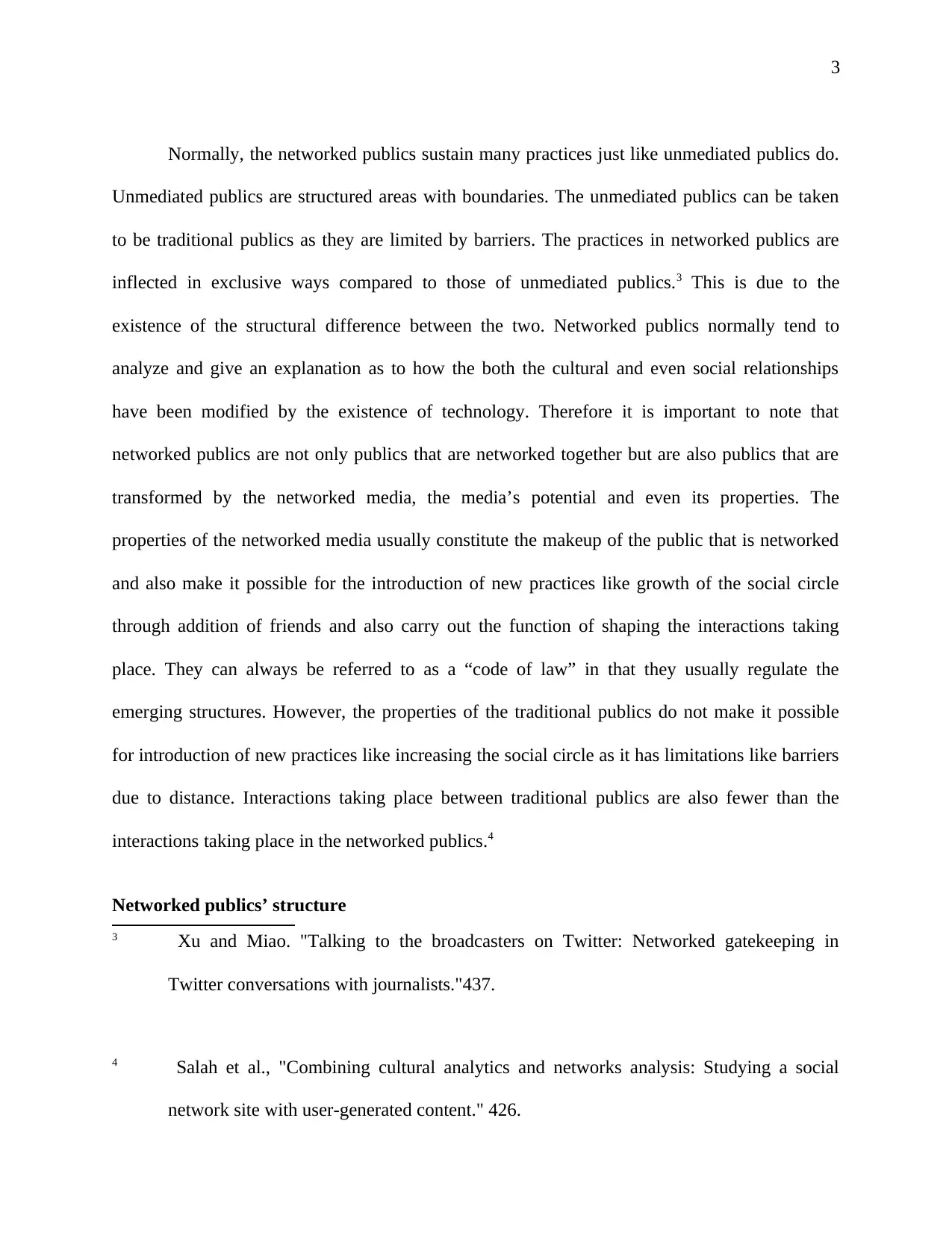
3
Normally, the networked publics sustain many practices just like unmediated publics do.
Unmediated publics are structured areas with boundaries. The unmediated publics can be taken
to be traditional publics as they are limited by barriers. The practices in networked publics are
inflected in exclusive ways compared to those of unmediated publics.3 This is due to the
existence of the structural difference between the two. Networked publics normally tend to
analyze and give an explanation as to how the both the cultural and even social relationships
have been modified by the existence of technology. Therefore it is important to note that
networked publics are not only publics that are networked together but are also publics that are
transformed by the networked media, the media’s potential and even its properties. The
properties of the networked media usually constitute the makeup of the public that is networked
and also make it possible for the introduction of new practices like growth of the social circle
through addition of friends and also carry out the function of shaping the interactions taking
place. They can always be referred to as a “code of law” in that they usually regulate the
emerging structures. However, the properties of the traditional publics do not make it possible
for introduction of new practices like increasing the social circle as it has limitations like barriers
due to distance. Interactions taking place between traditional publics are also fewer than the
interactions taking place in the networked publics.4
Networked publics’ structure
3 Xu and Miao. "Talking to the broadcasters on Twitter: Networked gatekeeping in
Twitter conversations with journalists."437.
4 Salah et al., "Combining cultural analytics and networks analysis: Studying a social
network site with user-generated content." 426.
Normally, the networked publics sustain many practices just like unmediated publics do.
Unmediated publics are structured areas with boundaries. The unmediated publics can be taken
to be traditional publics as they are limited by barriers. The practices in networked publics are
inflected in exclusive ways compared to those of unmediated publics.3 This is due to the
existence of the structural difference between the two. Networked publics normally tend to
analyze and give an explanation as to how the both the cultural and even social relationships
have been modified by the existence of technology. Therefore it is important to note that
networked publics are not only publics that are networked together but are also publics that are
transformed by the networked media, the media’s potential and even its properties. The
properties of the networked media usually constitute the makeup of the public that is networked
and also make it possible for the introduction of new practices like growth of the social circle
through addition of friends and also carry out the function of shaping the interactions taking
place. They can always be referred to as a “code of law” in that they usually regulate the
emerging structures. However, the properties of the traditional publics do not make it possible
for introduction of new practices like increasing the social circle as it has limitations like barriers
due to distance. Interactions taking place between traditional publics are also fewer than the
interactions taking place in the networked publics.4
Networked publics’ structure
3 Xu and Miao. "Talking to the broadcasters on Twitter: Networked gatekeeping in
Twitter conversations with journalists."437.
4 Salah et al., "Combining cultural analytics and networks analysis: Studying a social
network site with user-generated content." 426.
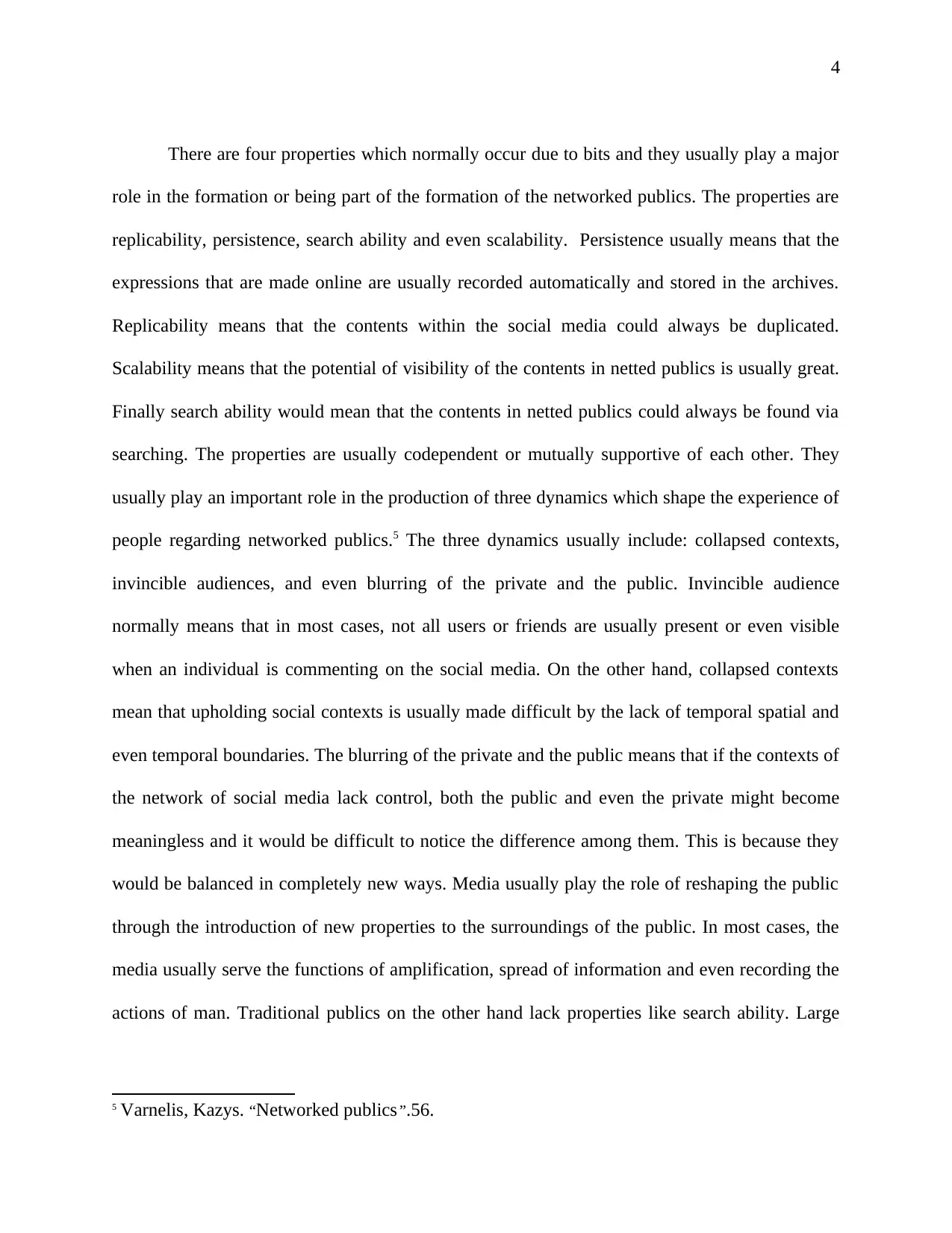
4
There are four properties which normally occur due to bits and they usually play a major
role in the formation or being part of the formation of the networked publics. The properties are
replicability, persistence, search ability and even scalability. Persistence usually means that the
expressions that are made online are usually recorded automatically and stored in the archives.
Replicability means that the contents within the social media could always be duplicated.
Scalability means that the potential of visibility of the contents in netted publics is usually great.
Finally search ability would mean that the contents in netted publics could always be found via
searching. The properties are usually codependent or mutually supportive of each other. They
usually play an important role in the production of three dynamics which shape the experience of
people regarding networked publics.5 The three dynamics usually include: collapsed contexts,
invincible audiences, and even blurring of the private and the public. Invincible audience
normally means that in most cases, not all users or friends are usually present or even visible
when an individual is commenting on the social media. On the other hand, collapsed contexts
mean that upholding social contexts is usually made difficult by the lack of temporal spatial and
even temporal boundaries. The blurring of the private and the public means that if the contexts of
the network of social media lack control, both the public and even the private might become
meaningless and it would be difficult to notice the difference among them. This is because they
would be balanced in completely new ways. Media usually play the role of reshaping the public
through the introduction of new properties to the surroundings of the public. In most cases, the
media usually serve the functions of amplification, spread of information and even recording the
actions of man. Traditional publics on the other hand lack properties like search ability. Large
5 Varnelis, Kazys. “Networked publics”.56.
There are four properties which normally occur due to bits and they usually play a major
role in the formation or being part of the formation of the networked publics. The properties are
replicability, persistence, search ability and even scalability. Persistence usually means that the
expressions that are made online are usually recorded automatically and stored in the archives.
Replicability means that the contents within the social media could always be duplicated.
Scalability means that the potential of visibility of the contents in netted publics is usually great.
Finally search ability would mean that the contents in netted publics could always be found via
searching. The properties are usually codependent or mutually supportive of each other. They
usually play an important role in the production of three dynamics which shape the experience of
people regarding networked publics.5 The three dynamics usually include: collapsed contexts,
invincible audiences, and even blurring of the private and the public. Invincible audience
normally means that in most cases, not all users or friends are usually present or even visible
when an individual is commenting on the social media. On the other hand, collapsed contexts
mean that upholding social contexts is usually made difficult by the lack of temporal spatial and
even temporal boundaries. The blurring of the private and the public means that if the contexts of
the network of social media lack control, both the public and even the private might become
meaningless and it would be difficult to notice the difference among them. This is because they
would be balanced in completely new ways. Media usually play the role of reshaping the public
through the introduction of new properties to the surroundings of the public. In most cases, the
media usually serve the functions of amplification, spread of information and even recording the
actions of man. Traditional publics on the other hand lack properties like search ability. Large
5 Varnelis, Kazys. “Networked publics”.56.
Secure Best Marks with AI Grader
Need help grading? Try our AI Grader for instant feedback on your assignments.
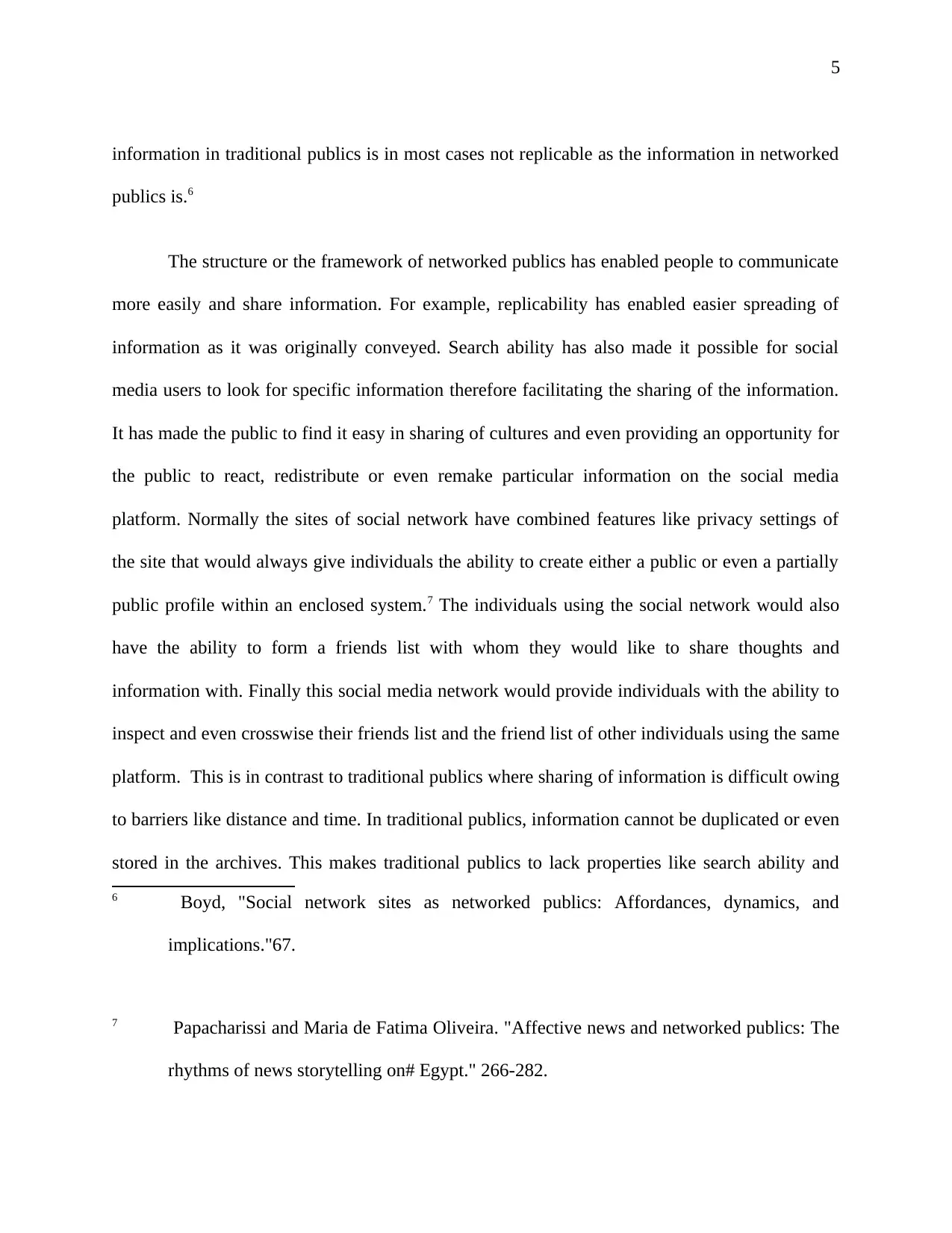
5
information in traditional publics is in most cases not replicable as the information in networked
publics is.6
The structure or the framework of networked publics has enabled people to communicate
more easily and share information. For example, replicability has enabled easier spreading of
information as it was originally conveyed. Search ability has also made it possible for social
media users to look for specific information therefore facilitating the sharing of the information.
It has made the public to find it easy in sharing of cultures and even providing an opportunity for
the public to react, redistribute or even remake particular information on the social media
platform. Normally the sites of social network have combined features like privacy settings of
the site that would always give individuals the ability to create either a public or even a partially
public profile within an enclosed system.7 The individuals using the social network would also
have the ability to form a friends list with whom they would like to share thoughts and
information with. Finally this social media network would provide individuals with the ability to
inspect and even crosswise their friends list and the friend list of other individuals using the same
platform. This is in contrast to traditional publics where sharing of information is difficult owing
to barriers like distance and time. In traditional publics, information cannot be duplicated or even
stored in the archives. This makes traditional publics to lack properties like search ability and
6 Boyd, "Social network sites as networked publics: Affordances, dynamics, and
implications."67.
7 Papacharissi and Maria de Fatima Oliveira. "Affective news and networked publics: The
rhythms of news storytelling on# Egypt." 266-282.
information in traditional publics is in most cases not replicable as the information in networked
publics is.6
The structure or the framework of networked publics has enabled people to communicate
more easily and share information. For example, replicability has enabled easier spreading of
information as it was originally conveyed. Search ability has also made it possible for social
media users to look for specific information therefore facilitating the sharing of the information.
It has made the public to find it easy in sharing of cultures and even providing an opportunity for
the public to react, redistribute or even remake particular information on the social media
platform. Normally the sites of social network have combined features like privacy settings of
the site that would always give individuals the ability to create either a public or even a partially
public profile within an enclosed system.7 The individuals using the social network would also
have the ability to form a friends list with whom they would like to share thoughts and
information with. Finally this social media network would provide individuals with the ability to
inspect and even crosswise their friends list and the friend list of other individuals using the same
platform. This is in contrast to traditional publics where sharing of information is difficult owing
to barriers like distance and time. In traditional publics, information cannot be duplicated or even
stored in the archives. This makes traditional publics to lack properties like search ability and
6 Boyd, "Social network sites as networked publics: Affordances, dynamics, and
implications."67.
7 Papacharissi and Maria de Fatima Oliveira. "Affective news and networked publics: The
rhythms of news storytelling on# Egypt." 266-282.
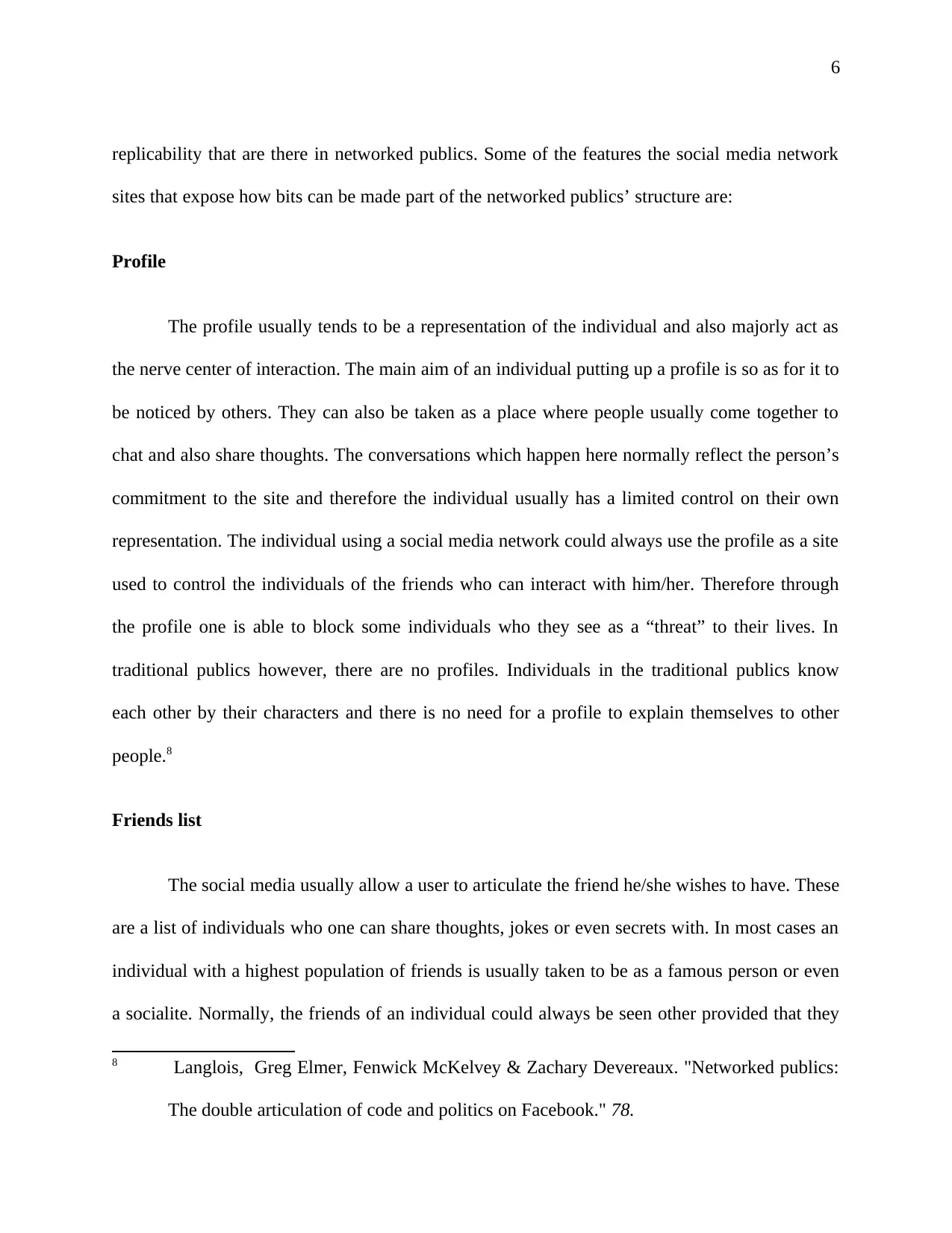
6
replicability that are there in networked publics. Some of the features the social media network
sites that expose how bits can be made part of the networked publics’ structure are:
Profile
The profile usually tends to be a representation of the individual and also majorly act as
the nerve center of interaction. The main aim of an individual putting up a profile is so as for it to
be noticed by others. They can also be taken as a place where people usually come together to
chat and also share thoughts. The conversations which happen here normally reflect the person’s
commitment to the site and therefore the individual usually has a limited control on their own
representation. The individual using a social media network could always use the profile as a site
used to control the individuals of the friends who can interact with him/her. Therefore through
the profile one is able to block some individuals who they see as a “threat” to their lives. In
traditional publics however, there are no profiles. Individuals in the traditional publics know
each other by their characters and there is no need for a profile to explain themselves to other
people.8
Friends list
The social media usually allow a user to articulate the friend he/she wishes to have. These
are a list of individuals who one can share thoughts, jokes or even secrets with. In most cases an
individual with a highest population of friends is usually taken to be as a famous person or even
a socialite. Normally, the friends of an individual could always be seen other provided that they
8 Langlois, Greg Elmer, Fenwick McKelvey & Zachary Devereaux. "Networked publics:
The double articulation of code and politics on Facebook." 78.
replicability that are there in networked publics. Some of the features the social media network
sites that expose how bits can be made part of the networked publics’ structure are:
Profile
The profile usually tends to be a representation of the individual and also majorly act as
the nerve center of interaction. The main aim of an individual putting up a profile is so as for it to
be noticed by others. They can also be taken as a place where people usually come together to
chat and also share thoughts. The conversations which happen here normally reflect the person’s
commitment to the site and therefore the individual usually has a limited control on their own
representation. The individual using a social media network could always use the profile as a site
used to control the individuals of the friends who can interact with him/her. Therefore through
the profile one is able to block some individuals who they see as a “threat” to their lives. In
traditional publics however, there are no profiles. Individuals in the traditional publics know
each other by their characters and there is no need for a profile to explain themselves to other
people.8
Friends list
The social media usually allow a user to articulate the friend he/she wishes to have. These
are a list of individuals who one can share thoughts, jokes or even secrets with. In most cases an
individual with a highest population of friends is usually taken to be as a famous person or even
a socialite. Normally, the friends of an individual could always be seen other provided that they
8 Langlois, Greg Elmer, Fenwick McKelvey & Zachary Devereaux. "Networked publics:
The double articulation of code and politics on Facebook." 78.
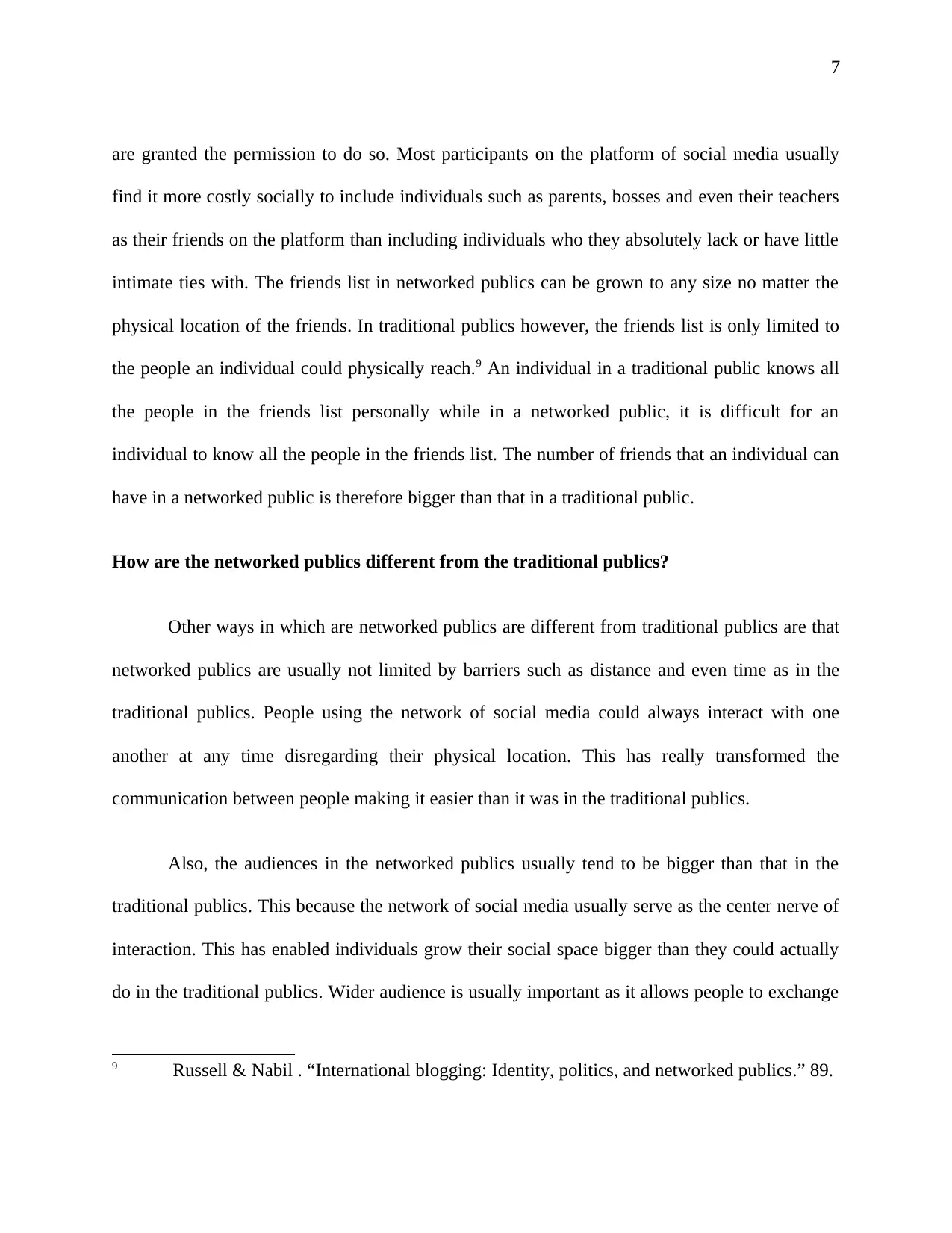
7
are granted the permission to do so. Most participants on the platform of social media usually
find it more costly socially to include individuals such as parents, bosses and even their teachers
as their friends on the platform than including individuals who they absolutely lack or have little
intimate ties with. The friends list in networked publics can be grown to any size no matter the
physical location of the friends. In traditional publics however, the friends list is only limited to
the people an individual could physically reach.9 An individual in a traditional public knows all
the people in the friends list personally while in a networked public, it is difficult for an
individual to know all the people in the friends list. The number of friends that an individual can
have in a networked public is therefore bigger than that in a traditional public.
How are the networked publics different from the traditional publics?
Other ways in which are networked publics are different from traditional publics are that
networked publics are usually not limited by barriers such as distance and even time as in the
traditional publics. People using the network of social media could always interact with one
another at any time disregarding their physical location. This has really transformed the
communication between people making it easier than it was in the traditional publics.
Also, the audiences in the networked publics usually tend to be bigger than that in the
traditional publics. This because the network of social media usually serve as the center nerve of
interaction. This has enabled individuals grow their social space bigger than they could actually
do in the traditional publics. Wider audience is usually important as it allows people to exchange
9 Russell & Nabil . “International blogging: Identity, politics, and networked publics.” 89.
are granted the permission to do so. Most participants on the platform of social media usually
find it more costly socially to include individuals such as parents, bosses and even their teachers
as their friends on the platform than including individuals who they absolutely lack or have little
intimate ties with. The friends list in networked publics can be grown to any size no matter the
physical location of the friends. In traditional publics however, the friends list is only limited to
the people an individual could physically reach.9 An individual in a traditional public knows all
the people in the friends list personally while in a networked public, it is difficult for an
individual to know all the people in the friends list. The number of friends that an individual can
have in a networked public is therefore bigger than that in a traditional public.
How are the networked publics different from the traditional publics?
Other ways in which are networked publics are different from traditional publics are that
networked publics are usually not limited by barriers such as distance and even time as in the
traditional publics. People using the network of social media could always interact with one
another at any time disregarding their physical location. This has really transformed the
communication between people making it easier than it was in the traditional publics.
Also, the audiences in the networked publics usually tend to be bigger than that in the
traditional publics. This because the network of social media usually serve as the center nerve of
interaction. This has enabled individuals grow their social space bigger than they could actually
do in the traditional publics. Wider audience is usually important as it allows people to exchange
9 Russell & Nabil . “International blogging: Identity, politics, and networked publics.” 89.
Paraphrase This Document
Need a fresh take? Get an instant paraphrase of this document with our AI Paraphraser

8
thoughts and cultures. This has also aided to widen an individual’s experience therefore also
widening the knowledge of the individual.10
Networked publics however have led to limited face to face interaction. Traditional
publics usually provided higher chances of face to face interaction. The limited interaction has
somehow contributed to the distancing of individual since a face to face interaction is usually
important in ensuring some sort of mutual connection between the individuals. The limited face
to face interaction enabled the people to live a more virtual life instead of living in the reality. It
can also be said that the contact within the participants in a networked public is lesser than the
contact between individuals in a traditional public.11
The cost of interaction in the networked public is usually lesser than the cost of
interaction of individuals in the traditional public. This is because, for example, for
communication or the sharing of information in traditional public to take place between two or
more individuals distant apart, some cost had to be incurred. However, in networked publics, the
cost of interaction and information sharing is usually relatively cheaper. This is because the
information put forward in the network of social media is replicable. This has aided to improve
the easy spread of information between the participants and usually within a short time; the
information will have reached a larger group of participants through the replication of the
10 Wellman, "Physical place and cyberplace: The rise of personalized networking." 227-
252.
11 Lougheed, "Frazzled by Facebook? An exploratory study of gender differences in social
network communication among undergraduate men and women." 88-99.
thoughts and cultures. This has also aided to widen an individual’s experience therefore also
widening the knowledge of the individual.10
Networked publics however have led to limited face to face interaction. Traditional
publics usually provided higher chances of face to face interaction. The limited interaction has
somehow contributed to the distancing of individual since a face to face interaction is usually
important in ensuring some sort of mutual connection between the individuals. The limited face
to face interaction enabled the people to live a more virtual life instead of living in the reality. It
can also be said that the contact within the participants in a networked public is lesser than the
contact between individuals in a traditional public.11
The cost of interaction in the networked public is usually lesser than the cost of
interaction of individuals in the traditional public. This is because, for example, for
communication or the sharing of information in traditional public to take place between two or
more individuals distant apart, some cost had to be incurred. However, in networked publics, the
cost of interaction and information sharing is usually relatively cheaper. This is because the
information put forward in the network of social media is replicable. This has aided to improve
the easy spread of information between the participants and usually within a short time; the
information will have reached a larger group of participants through the replication of the
10 Wellman, "Physical place and cyberplace: The rise of personalized networking." 227-
252.
11 Lougheed, "Frazzled by Facebook? An exploratory study of gender differences in social
network communication among undergraduate men and women." 88-99.
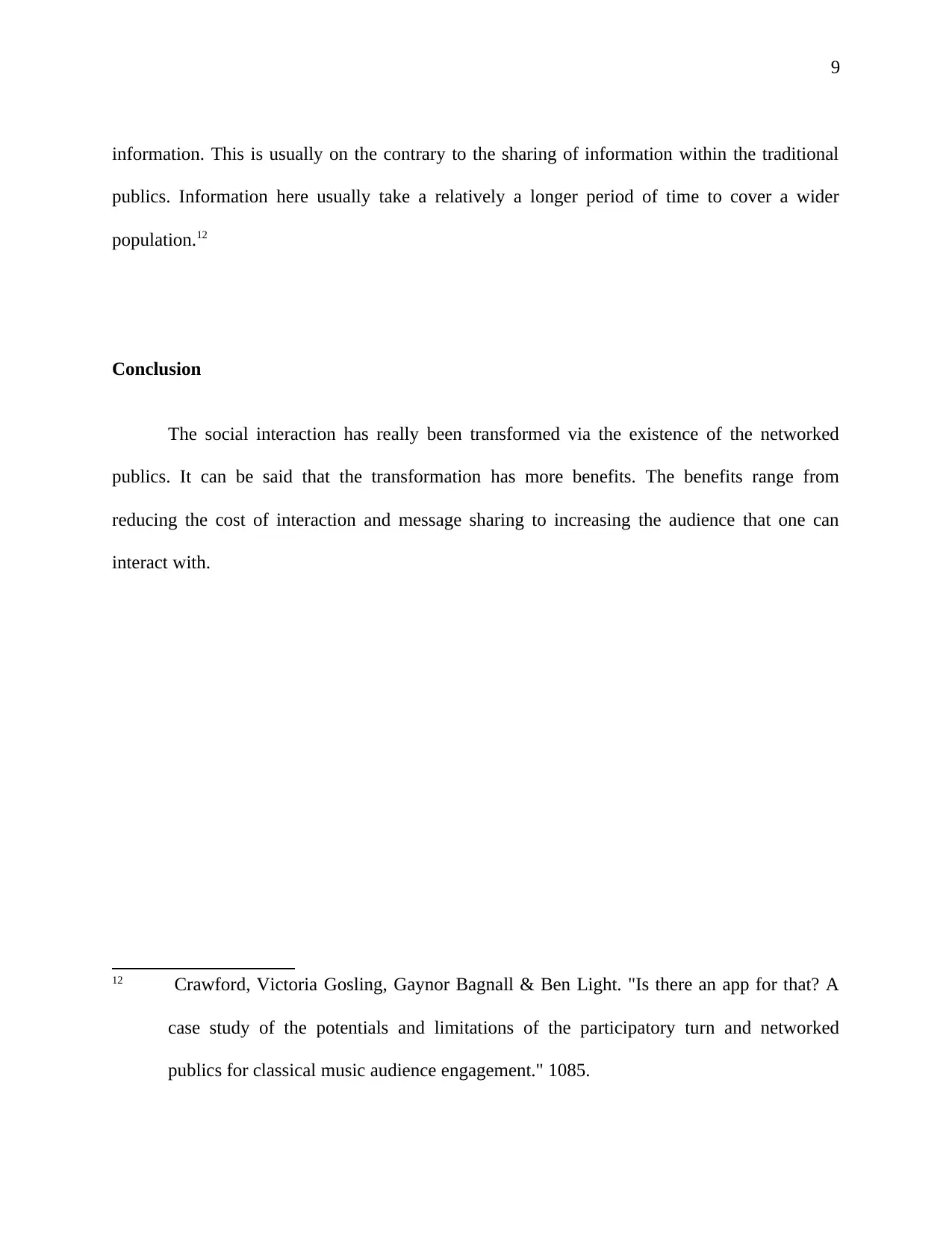
9
information. This is usually on the contrary to the sharing of information within the traditional
publics. Information here usually take a relatively a longer period of time to cover a wider
population.12
Conclusion
The social interaction has really been transformed via the existence of the networked
publics. It can be said that the transformation has more benefits. The benefits range from
reducing the cost of interaction and message sharing to increasing the audience that one can
interact with.
12 Crawford, Victoria Gosling, Gaynor Bagnall & Ben Light. "Is there an app for that? A
case study of the potentials and limitations of the participatory turn and networked
publics for classical music audience engagement." 1085.
information. This is usually on the contrary to the sharing of information within the traditional
publics. Information here usually take a relatively a longer period of time to cover a wider
population.12
Conclusion
The social interaction has really been transformed via the existence of the networked
publics. It can be said that the transformation has more benefits. The benefits range from
reducing the cost of interaction and message sharing to increasing the audience that one can
interact with.
12 Crawford, Victoria Gosling, Gaynor Bagnall & Ben Light. "Is there an app for that? A
case study of the potentials and limitations of the participatory turn and networked
publics for classical music audience engagement." 1085.
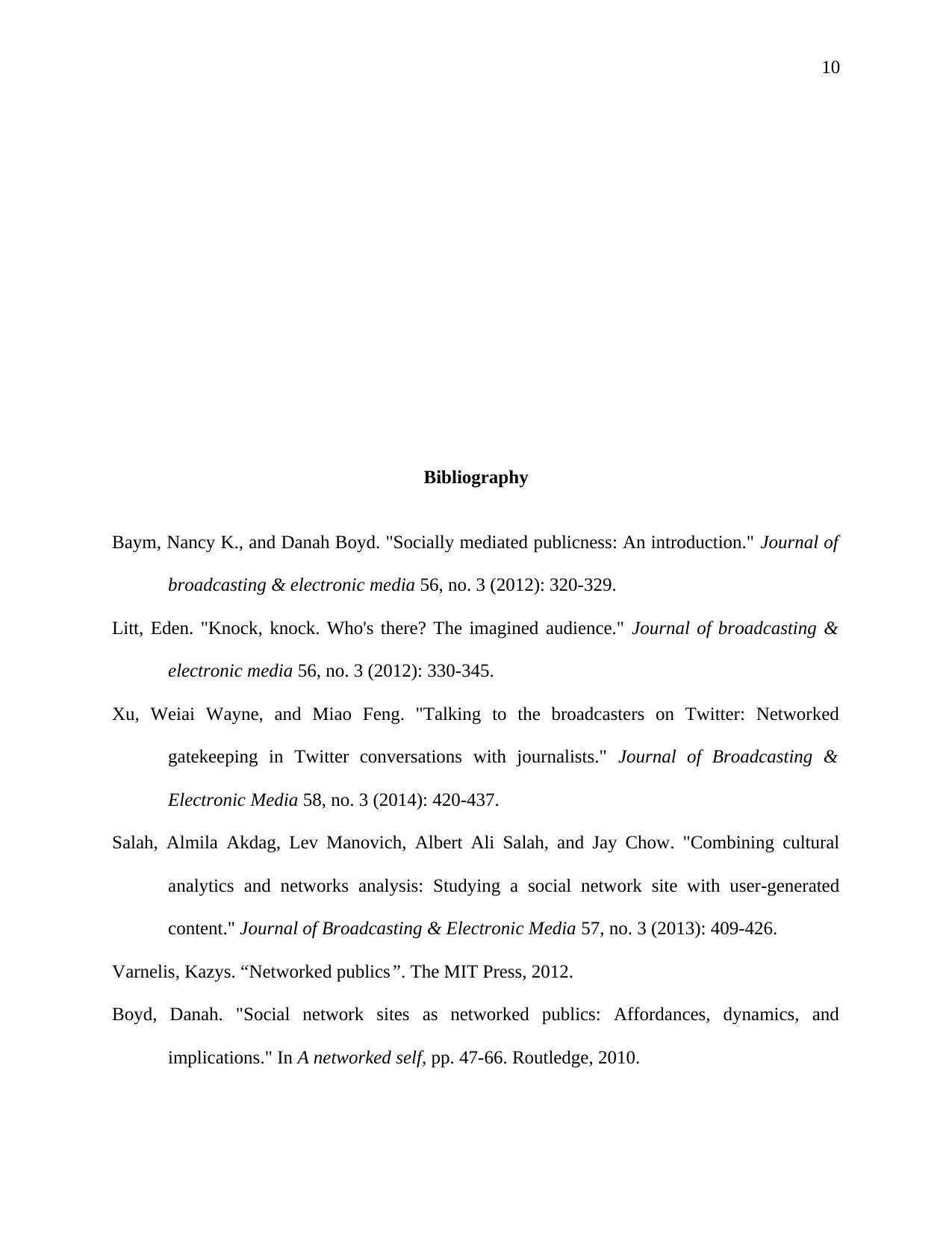
10
Bibliography
Baym, Nancy K., and Danah Boyd. "Socially mediated publicness: An introduction." Journal of
broadcasting & electronic media 56, no. 3 (2012): 320-329.
Litt, Eden. "Knock, knock. Who's there? The imagined audience." Journal of broadcasting &
electronic media 56, no. 3 (2012): 330-345.
Xu, Weiai Wayne, and Miao Feng. "Talking to the broadcasters on Twitter: Networked
gatekeeping in Twitter conversations with journalists." Journal of Broadcasting &
Electronic Media 58, no. 3 (2014): 420-437.
Salah, Almila Akdag, Lev Manovich, Albert Ali Salah, and Jay Chow. "Combining cultural
analytics and networks analysis: Studying a social network site with user-generated
content." Journal of Broadcasting & Electronic Media 57, no. 3 (2013): 409-426.
Varnelis, Kazys. “Networked publics”. The MIT Press, 2012.
Boyd, Danah. "Social network sites as networked publics: Affordances, dynamics, and
implications." In A networked self, pp. 47-66. Routledge, 2010.
Bibliography
Baym, Nancy K., and Danah Boyd. "Socially mediated publicness: An introduction." Journal of
broadcasting & electronic media 56, no. 3 (2012): 320-329.
Litt, Eden. "Knock, knock. Who's there? The imagined audience." Journal of broadcasting &
electronic media 56, no. 3 (2012): 330-345.
Xu, Weiai Wayne, and Miao Feng. "Talking to the broadcasters on Twitter: Networked
gatekeeping in Twitter conversations with journalists." Journal of Broadcasting &
Electronic Media 58, no. 3 (2014): 420-437.
Salah, Almila Akdag, Lev Manovich, Albert Ali Salah, and Jay Chow. "Combining cultural
analytics and networks analysis: Studying a social network site with user-generated
content." Journal of Broadcasting & Electronic Media 57, no. 3 (2013): 409-426.
Varnelis, Kazys. “Networked publics”. The MIT Press, 2012.
Boyd, Danah. "Social network sites as networked publics: Affordances, dynamics, and
implications." In A networked self, pp. 47-66. Routledge, 2010.
Secure Best Marks with AI Grader
Need help grading? Try our AI Grader for instant feedback on your assignments.
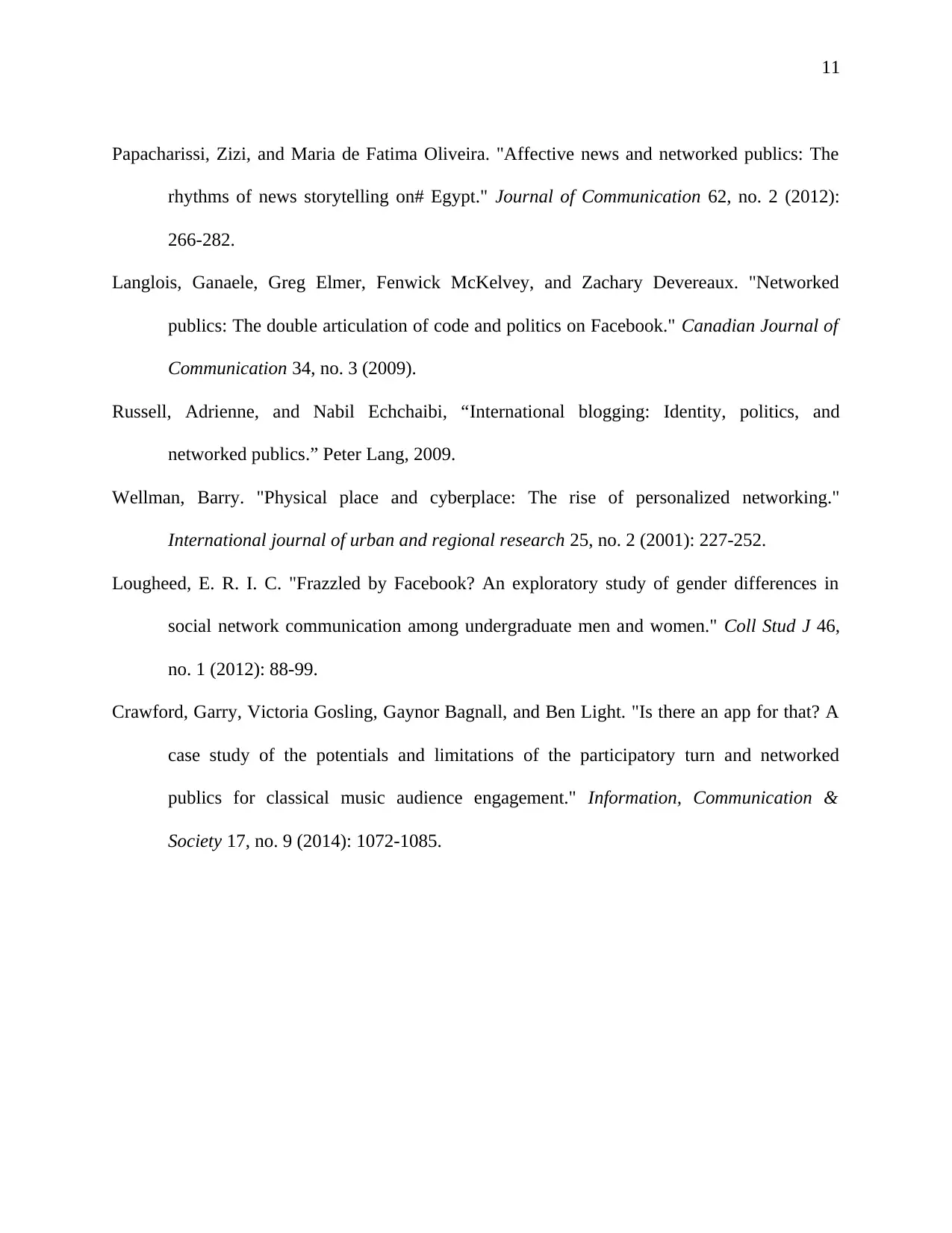
11
Papacharissi, Zizi, and Maria de Fatima Oliveira. "Affective news and networked publics: The
rhythms of news storytelling on# Egypt." Journal of Communication 62, no. 2 (2012):
266-282.
Langlois, Ganaele, Greg Elmer, Fenwick McKelvey, and Zachary Devereaux. "Networked
publics: The double articulation of code and politics on Facebook." Canadian Journal of
Communication 34, no. 3 (2009).
Russell, Adrienne, and Nabil Echchaibi, “International blogging: Identity, politics, and
networked publics.” Peter Lang, 2009.
Wellman, Barry. "Physical place and cyberplace: The rise of personalized networking."
International journal of urban and regional research 25, no. 2 (2001): 227-252.
Lougheed, E. R. I. C. "Frazzled by Facebook? An exploratory study of gender differences in
social network communication among undergraduate men and women." Coll Stud J 46,
no. 1 (2012): 88-99.
Crawford, Garry, Victoria Gosling, Gaynor Bagnall, and Ben Light. "Is there an app for that? A
case study of the potentials and limitations of the participatory turn and networked
publics for classical music audience engagement." Information, Communication &
Society 17, no. 9 (2014): 1072-1085.
Papacharissi, Zizi, and Maria de Fatima Oliveira. "Affective news and networked publics: The
rhythms of news storytelling on# Egypt." Journal of Communication 62, no. 2 (2012):
266-282.
Langlois, Ganaele, Greg Elmer, Fenwick McKelvey, and Zachary Devereaux. "Networked
publics: The double articulation of code and politics on Facebook." Canadian Journal of
Communication 34, no. 3 (2009).
Russell, Adrienne, and Nabil Echchaibi, “International blogging: Identity, politics, and
networked publics.” Peter Lang, 2009.
Wellman, Barry. "Physical place and cyberplace: The rise of personalized networking."
International journal of urban and regional research 25, no. 2 (2001): 227-252.
Lougheed, E. R. I. C. "Frazzled by Facebook? An exploratory study of gender differences in
social network communication among undergraduate men and women." Coll Stud J 46,
no. 1 (2012): 88-99.
Crawford, Garry, Victoria Gosling, Gaynor Bagnall, and Ben Light. "Is there an app for that? A
case study of the potentials and limitations of the participatory turn and networked
publics for classical music audience engagement." Information, Communication &
Society 17, no. 9 (2014): 1072-1085.
1 out of 11
Related Documents
Your All-in-One AI-Powered Toolkit for Academic Success.
+13062052269
info@desklib.com
Available 24*7 on WhatsApp / Email
![[object Object]](/_next/static/media/star-bottom.7253800d.svg)
Unlock your academic potential
© 2024 | Zucol Services PVT LTD | All rights reserved.





